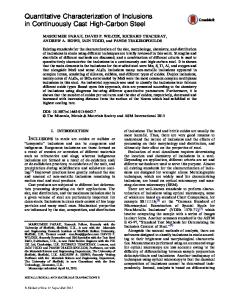Effects of MgO Nanoparticle Additions on the Structure and Mechanical Properties of Continuously Cast Steel Billets
- PDF / 5,020,112 Bytes
- 10 Pages / 593.972 x 792 pts Page_size
- 26 Downloads / 460 Views
RODUCTION
DURING recent years, there have been increasing efforts[1–5] to develop steel materials with improved mechanical properties to meet the strong demand from many heavy industries. It is well known that refining of the steel microstructure can significantly improve mechanical properties, particularly strength, plasticity, and toughness. The refining methods generally involve retarding austenite grain growth and developing fine acicular ferrite structure, thus improving the mechanical properties primarily through impeding dislocation movement within the microstructure when external forces are applied. To obtain appropriate microstructures, precipitation strengthening and thermo-mechanical processing are the most common methods.[6,7] Generally, the latter can be achieved during actual production through austenite non-recrystallization controlled rolling,[8] strain-induced transformation, and
XIANGZHOU GAO, Ph.D. Candidate, SHUFENG YANG, Associate Professor, and JINGSHE LI, Professor, are with the State Key Laboratory of Advanced Metallurgy, University of Science and Technology Beijing, Beijing, 100083, P.R. China, and also with the School of Metallurgical and Ecological Engineering, University of Science and Technology Beijing. Contact e-mail: yangshufeng@ ustb.edu.cn YINDONG YANG, Senior Research Associate, KINNOR CHATTOPADHYAY, Assistant Professor, and ALEX MCLEAN, Professor Emeritus, are with the Department of Materials Science and Engineering, University of Toronto, Toronto, ON, M5S 3E4, Canada. Manuscript submitted August 8, 2015. Article published online November 12, 2015 METALLURGICAL AND MATERIALS TRANSACTIONS A
accelerated cooling.[9,10] However, the precise control of important parameters such as micro-alloy content, cooling, and rolling conditions must be specifically investigated in order to satisfy the individual requirements of different steels, all of which increases the complexity of process control. The precipitation strengthening method was first proposed by Zener[11] in 1949. This involves incorporating micro second phase particles in the steel to retard the growth of austenite grain and induce intragranular acicular ferrite (IAF) as the nucleation cores of ferrites. These second phase particles can be generated either by an internal precipitation method (IPM) or by an external addition method (EAM). Hitherto, the majority of researchers have focused on an IPM to obtain small-sized, thermally stable, second phases, generally less than or equal to 1 lm,[12] through adjusting steel chemistry and steelmaking conditions. This refinement mechanism is basically consistent with ‘‘oxide metallurgy’’ theory.[13,14] Many experiments have been performed to study the ability of titanium oxides to promote the formation of AF and it has been concluded that Ti2O3 is superior to other species in this regard.[15–20] Additional studies[21–23] indicate that inclusions such as zirconium oxides, titanium, niobium and vanadium carbonitrides, cerium sulfides, and high-melting titanium nitride also serve as heterogeneous nu
Data Loading...











